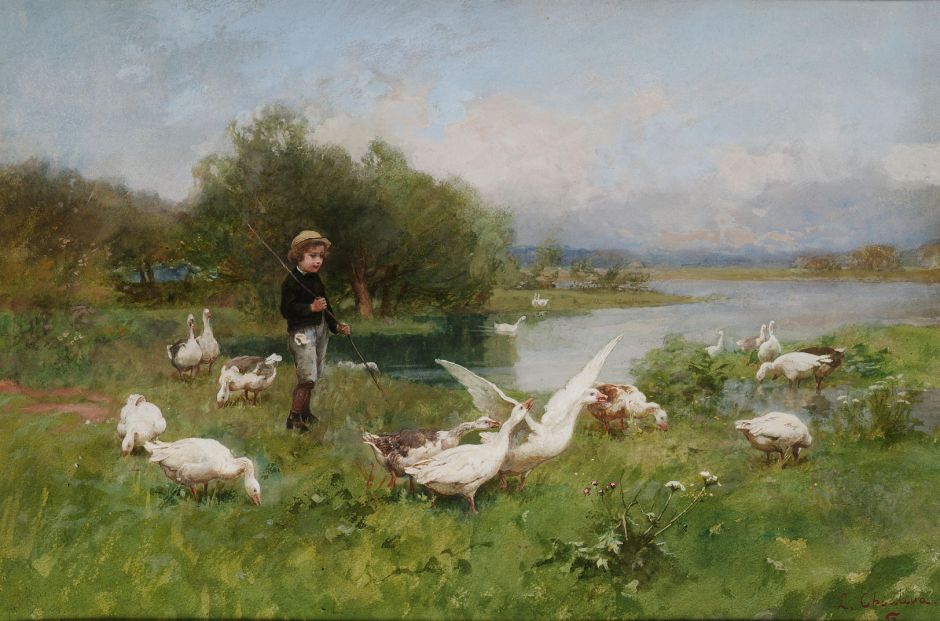In the first of this pair of articles looking at geese in painting, I concentrated on the birds themselves. Here I look at a motif which, for a couple of decades, became popular in paintings: the Goose Girl.
Geese are sufficiently aggressive to function as both intruder alarms and armed guards, so don’t need the protection of human shepherds. They do need to be watched and controlled, and periodically moved on to fresh grazing – an ideal task for the children.

Some geese are so special that they were made sacred, as in those of Juno which were kept on the Capitol hill in ancient Rome. Henri-Paul Motte’s Naturalist painting of Sacred Geese of the Capitol from 1889 shows them being kept in ornate cages, although this loose goose seems to be arguing with one of the priestesses responsible for their care.
They are claimed to have saved the city of Rome from invasion by the Gauls in about 390 BCE, by raising the alarm and waking sleeping Roman soldiers with their watch dogs. But this priestess is no Goose Girl.
I am sure there are earlier examples of this motif, but the first that really comes to attention is one of the most puzzling.

During the late 1850s, Jean-François Millet developed a series of studies which culminated in his painting of The Goose Girl in about 1863. She is here a quite incongruous contemporary nude set in a backdrop of the artist’s evolving social realism. This young woman, who is supposed to be tending the large flock of geese further along the river, has stripped off her working clothes and stepped out of her coarse wooden clogs to bathe herself in the river. She still wears a kerchief over her hair as an obvious mark of her ‘peasant’ status.
The result is certainly original, but I think it makes the viewer feel a voyeur, something that classical nudes in a rustic setting generally avoid, and not, I’m sure, the artist’s intention. The cattle seen at the top right also seem out of place.

Less than a decade later, the next in what was becoming a steady stream of paintings of the Goose Girl appeared: Ludwig Knaus’s Cake at Teatime (1872). She has thankfully recovered her clothes, and stands against a gate with a harvest-time landscape behind. A gaggle of geese are feeding avidly from what clearly isn’t cake, but scraps of greens from the kitchen waste.

In this very loose painting by Teodor Axentowicz in 1883, his Goose Girl walks with a large flock of geese on flat and marshy land beside a river.
Over the period between Knaus’s painting and the end of the century, there was a succession of paintings from other artists exploring this motif.

Wilhelm Friedenberg’s undated The Goose Girl’s Lunch shows a younger girl, plainly dressed as a ‘peasant’ and barefoot, sat as she enjoys a short break with her lunch. A younger brother, who presumably brought the wicker basket out to her, is asleep by her side.

Luigi Chialiva is one of very few artists to have painted not a Goose Girl but a Young Boy Tending Geese, in this painterly watercolour.

Attention then turned away from the pastoral setting and the birds to the young girls themselves. In Jendrassik Jenö’s The Little Goose Girl, his young subject is full of ennui, her back to the geese, staring into the distance.

Julien Dupré’s Naturalist painting In the Meadow, which was completed before 1891, shows a young mother holding her son’s hand as she steers a protesting goose with her stick.

It was perhaps William-Adolphe Bouguereau’s Goose Girl from 1891 which became the best-known example. She stands barefoot, her stick tucked under her left arm like a sergeant-major’s swagger stick, her head turned to look directly at the viewer. Instead of Jenö’s ennui, she smiles with deep confidence in her natural beauty. We could almost forgive the artist for his obvious studio composition.

Nikolai Bodarevsky’s goose girl is far less content. Seen in Little Russia. A Girl with Geese from 1892, this is set in what is now the Ukraine. Barefoot and dressed as a ‘peasant’, her gaze and mind have drifted far away from the geese with their young goslings in front of her.

For me, the consummate of these paintings is Léon Lhermitte’sThe Goose Girl of Mézy from 1892. Following the model set by Jules Bastien-Lepage’s waifs and strays, she stands sullen and sultry, defending her small flock of geese as she gleans for wheat left after the harvest. Her pinafore seems to have been handed down through the generations, and with its gaping holes is a shadow of its former self. But the last thing that she seeks is your pity or charitable handouts.

By the start of the twentieth century, the Goose Girl had moved on with her noisome birds. A few more paintings appear, such as the Canadian Clarence Gagnon’s Brittany Goose Girl from 1908. She walks along in her wooden clogs quietly knitting in the golden sunlight of autumn.

The American Japoniste print-maker Helen Hyde, who died a century ago tomorrow, shows a young Japanese girl arguing with her birds in Complaints from 1914.
The stereotype Goose Girl seems young, poor, barefoot, and thoroughly bored. Little does she know that later in life, she will be seeing to those geese in a different way, as shown in Max Liebermann’s Women Plucking Geese from 1871-72. Perhaps it’s as well that neither she nor her geese know their ultimate fate.


